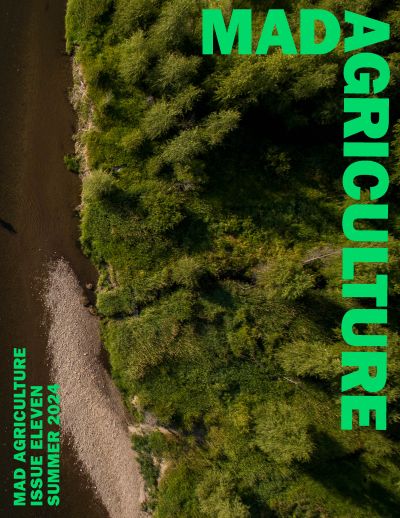
The Mad Agriculture Journal
The Farmer & the Fish
Published on
August 03, 2024
written by
Michaela Elias
Photos by
Joshua Duplechian
Jane Cavagnero
Michaela Elias
There is a reason that rivers and streams are referred to as arteries. They transport water, sediment, and solutes through a network of veins that crisscross a landscape, eventually depositing their contents in the ocean. And outside of the fisherman, maybe no profession is more bound up in this aqueous circulatory system than farmers. Farmers interact with rivers in two ways. The first is that they siphon water from them. The second is that rivers whisk away agricultural runoff. As the use of synthetic fertilizers and chemicals has increased, so has the amount of toxins entering these arteries. Increased pollution and low water levels have led to a smorgasbord of impacts, from the depletion of biodiversity and ecosystem stability to human health consequences and the loss of cultural practices and food sovereignty for tribes whose existence is also enmeshed with these rivers. Agriculture is not the only industry that pollutes rivers or extracts water. But they are a vital part of this story. This is a portrait of three farmers who have dedicated their careers to not only maintaining their own operations but to ensuring there is a future for farmers in a water-challenged world.
Ryan Walker - California
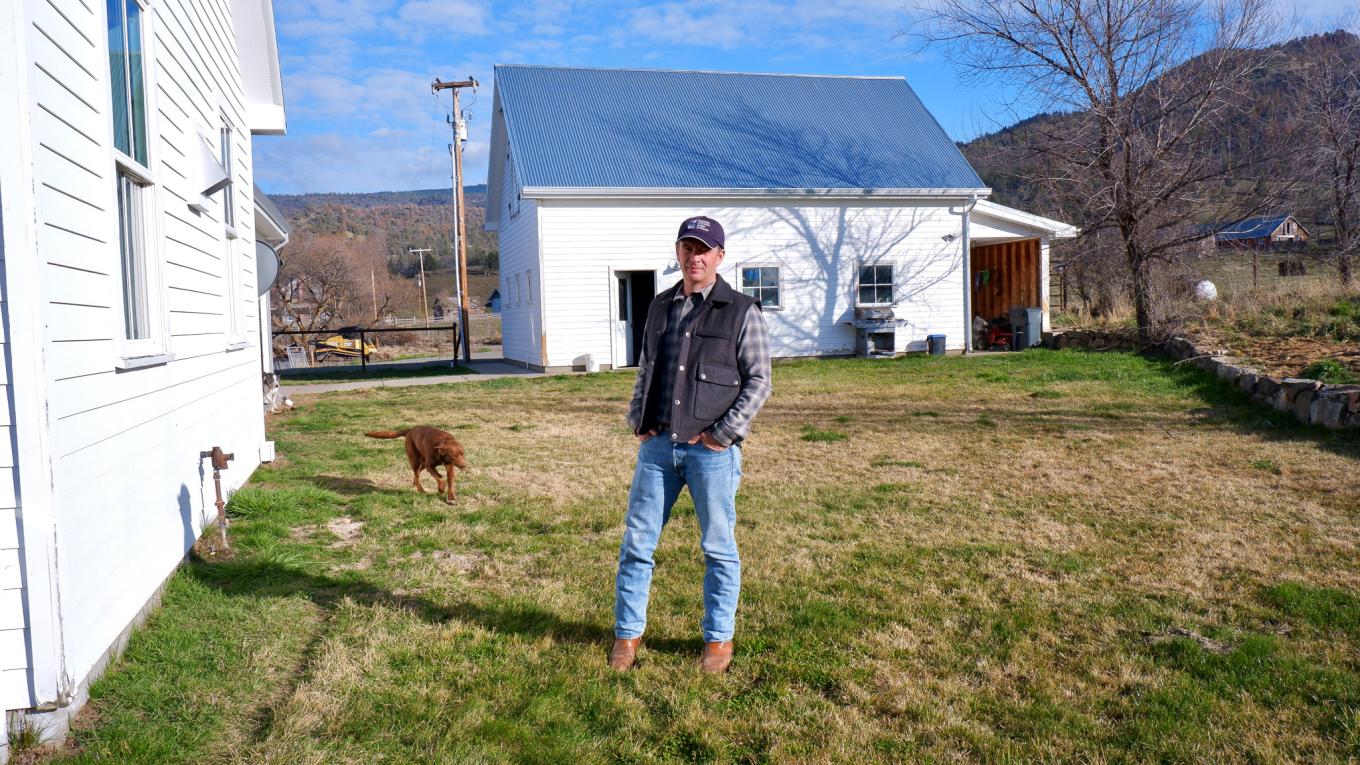
Michaela Elias
Ryan Walker’s ranch sits in a peaceful valley in Siskiyou County, California, home to Mount Shasta, over 370 former goldmines, and the lower part of the Klamath River, the second-largest river in the state. One of the biggest environmental news stories of the year is that four hydroelectric dams on the Klamath are coming down, marking the largest dam removal and river restoration project in history. This development has been a long time coming for many, especially the tribes in the Klamath Basin, who have fought for over two decades for the dams removal in hopes of restoring the salmon runs that were once the nation’s third-largest. Over the last century, water diversions, intensive agriculture, and rising water temperatures have caused salmon runs to decline by more than 90 percent (1). Ryan hopes that dam removal will help rebuild salmon populations. But he is concerned that he and many other Klamath Basin farmers will lose access to their irrigation water if the fish don’t recover or are negatively impacted by the sediment flows post-removal, which even proponents of dam removal recognize is almost inevitable in the short-term. After years of emergency drought measures, any further water cuts could be ruinous.
Ryan’s parents bought the ranch in 1976, and he and his wife took over the operation in 2005. “We didn’t know how to raise a kid in the city,” he says, “Our parents just told us to go play in the mud or find pollywogs.” Ryan recalls the spotted owl wars, a period between the late 1980s and mid-2000s when loggers and environmentalists fought over the endangered listing of the Northern Spotted Owl, as a moment when farmers in the Klamath Basin began to realize that these larger environmental issues would impact their operations. Not long after, certain species of Klamath River salmon were listed as endangered. During this time, Ryan also felt the public perception of farmers start to shift. They were no longer the people feeding the world. They were part of the problem. That sentiment and the mounting regulations have made it increasingly difficult to sell this lifestyle to the next generation.
The story of Bogus Creek, which borders JJJ Ranch and is a tributary to the Klamath, provides an interesting window into the evolving relationship between farmers and rivers. Ryan’s ranch gets most of its irrigation water from cold, fairly reliable springs that emerge from a basalt layer laid over a historic waterway. Ryan also has a riparian right—the ability to make reasonable use of water from a source that abuts your property—on Bogus Creek, which he only uses in the spring and in wet years. It is currently a 90 degree and some change mid-July day as we hop in Ryan’s truck and head to the creek.
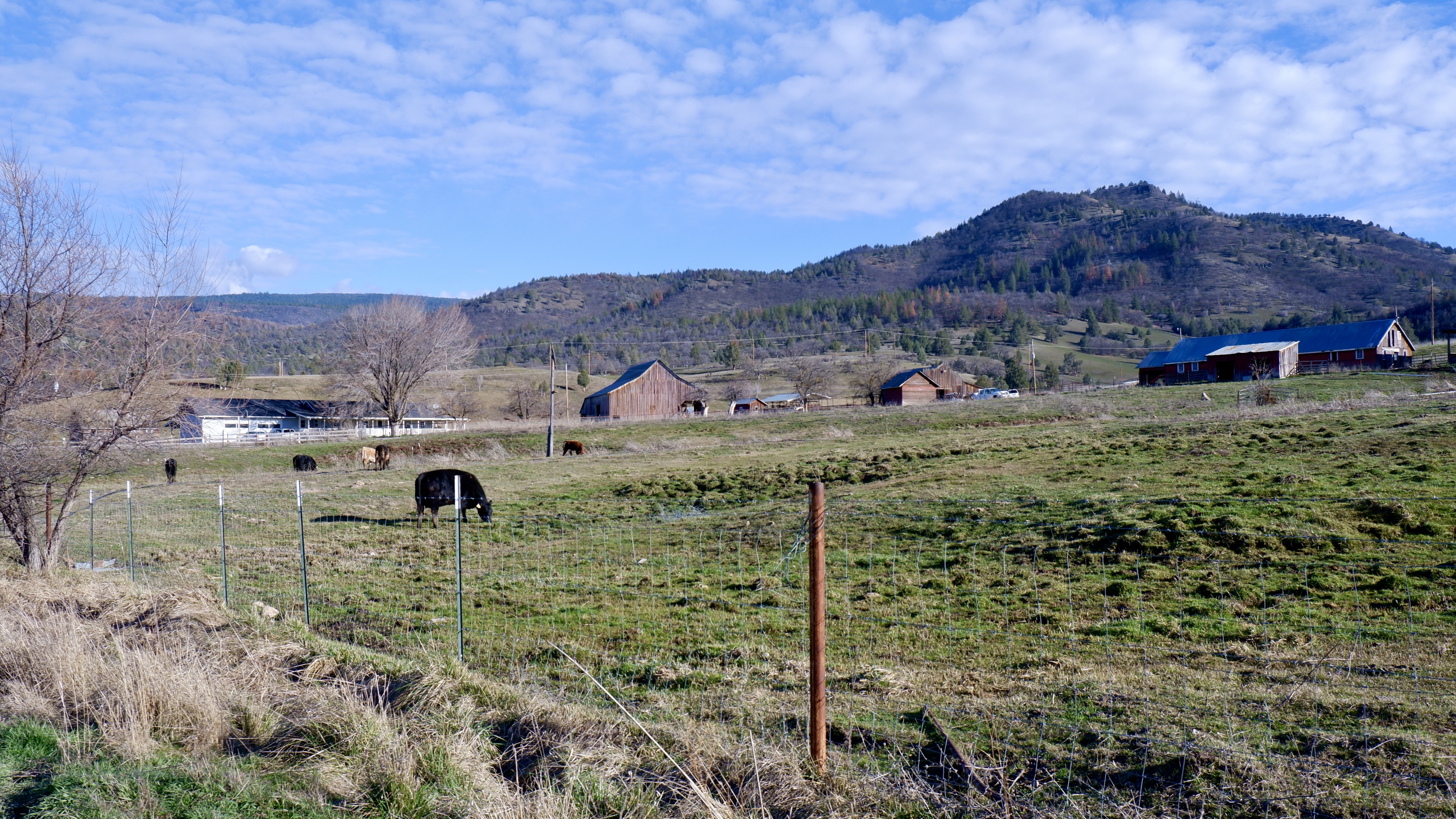
Michaela Elias
When we get out, we’re standing on a metal grate traversing a modest stream. So I’m taken aback when Ryan declares that gallon for gallon, this is the best salmon-producing stream in the entire system. In the early 2000s, Bogus Creek was listed as being over the daily limit for temperature and sediment; Ryan says that all the Klamath tributaries were listed simultaneously. Since then, Ryan and his neighbors have gone to all lengths to optimize Bogus Creek for fish habitat. They built fencing along the length of the creek to exclude cows and a berm to catch tailwater. They replaced and piped diversions. A million and a half dollars were spent recontouring a spawning reach, rock by rock, to create the ideal gradient for fish passage. All this work was paid for by a mix of government and nonprofit grants and the farmers themselves.
Before the Klamath dams, there were no salmon in this stretch of the creek. About a mile and a half downstream of Ryan’s ranch, there is a 20-foot waterfall that salmon, despite their remarkable athleticism, could not scale. After the dams were built, the Department of Fish and Wildlife (DFW), in search of alternative habitat, installed a fish ladder in Bogus Creek to open up the higher reaches to spawning salmon. Now that salmon are listed as endangered, these ranchers are on the hook for maintaining fish numbers.
Despite the salmon being relative newcomers, Ryan and his neighbors are proud of what they have achieved in their clear, cold creek. But at the same time, it feels like they’re trying to run upstream. At one point, Cheryl Foster, whose family owns Bogus Creek Ranch next door, stopped by on her way to test moisture in her hay bales. Ryan and Cheryl started, only somewhat jokingly, to hatch a plan to inspect the pools near the fish ladder. Their suspicion is that DFW is not clearing the pools to allow enough depth for fish to actually climb the ladder. After all, the government officials who installed it have since retired. But there is no moving on for Ryan and Cheryl. At least not if they can help it. “We’re here forever. You can’t just walk away from it,” Cheryl says.
Ryan’s experience with Bogus Creek has left him with some frustration towards regulators who have not always worked with farmers to implement changes and may not share the same long-term perspective that comes from direct reliance on the land and water. But the tribes along the Klamath do share this viewpoint. Though relations between the farmers and the tribes have not always been easy, Ryan sees a number of opportunities for collaboration between the two communities. According to Ryan, there are already several projects in motion that would have been unimaginable a few years ago. “The reality is the tribes have become knowledgeable in farming, and we’ve become knowledgeable about fish,” he says.
The farmers and the fish have become entwined. And in many ways, that’s a good thing. Ryan says the emphasis used to be on maximizing water levels for the fish at any cost. But there is a growing realization that good habitat is just as critical as high water levels. That’s where the farmer comes in. They must become stewards of the streams bisecting and bordering their properties if they are to meet conservation needs and retain water access in the long run.
I asked Ryan what he would say to people who claim there just isn’t enough water to go around. That somethings gotta give. “Well, maybe,” he says. “But can’t we at least try some of these solutions and then come to that conclusion?”
Paul Bruchez - Colorado
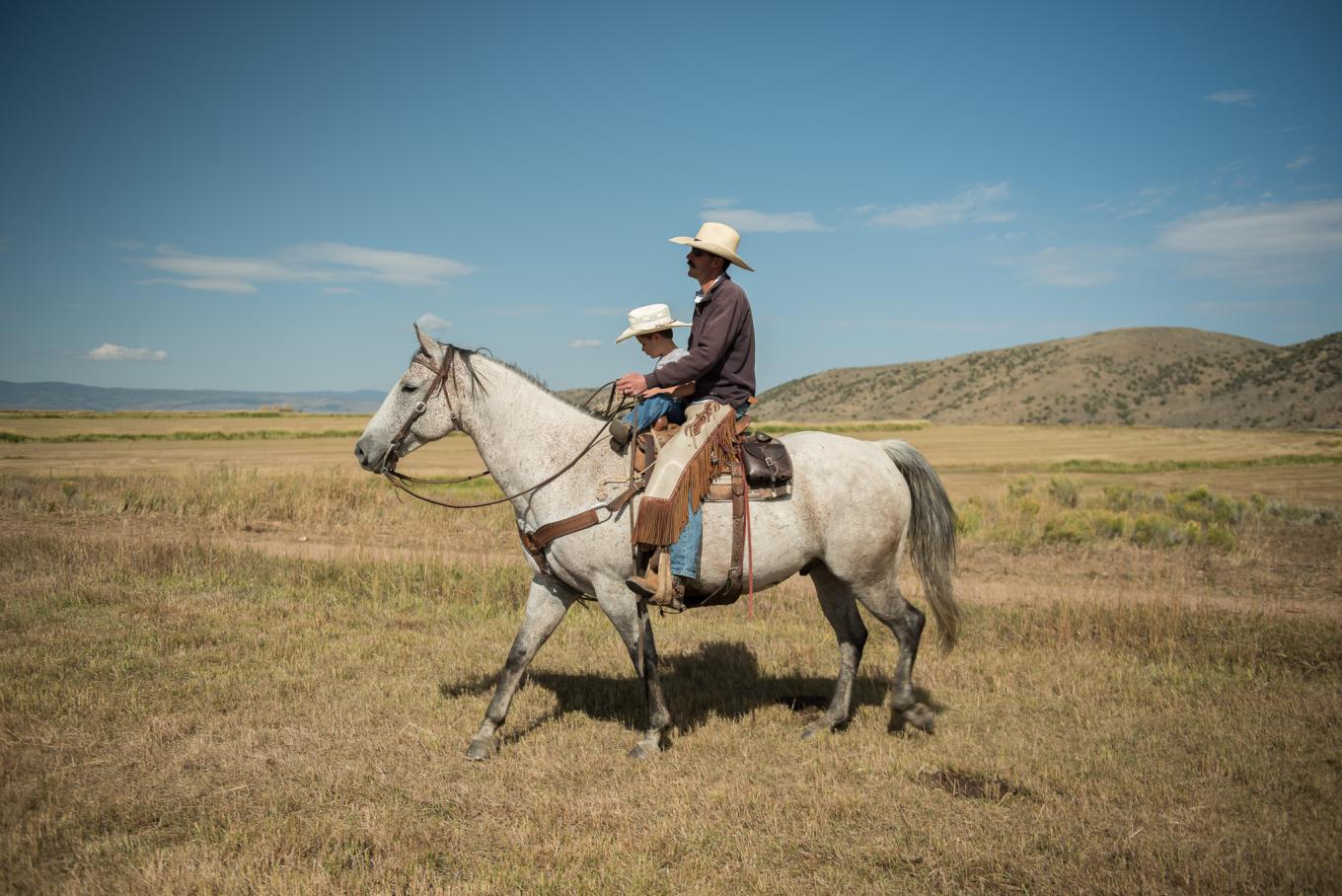
Joshua Duplechian
I met Paul in his barn near Kremmling, Colorado, in Grand County, a region nestled amongst the impressive Rocky Mountain peaks about two hours west of Denver. Paul and his brother graze about 500 cows at Reeder Creek Ranch. The crown jewel of the property is the great Colorado River that meanders through the pastures. Few people understand the connection between river and ranch better than Paul. In addition to operating the ranch, he and his family also run a fly fishing business on the river.
As far as irrigation goes, the Colorado is an agricultural behemoth. Farmers use 80 percent of the water (2) from the river to supply 15 percent of the country’s farmland and produce 90 percent of our winter vegetables. The Colorado can do a lot, but we have asked too much. The river has been overallocated since the signing of the Colorado River Compact (3) in 1922, the effects of which have been compounded by climate change. In the early 2020s, the two largest reservoirs in the country, both situated on the Colorado, drained to a third of their original volume. While Reeder Creek Ranch and their neighbors technically hold senior water rights in the West’s “first in time, first in right” system, in reality, farmers hold far less power and political sway than the burgeoning cities of Denver, Boulder, and Colorado Springs which have steadily bought up farmers’ water rights.
I first visited Paul in the summer of 2021. At the time, Colorado was investigating a demand management program. The idea of such a program, which would pay water users to conserve water on a temporary and voluntary basis, was met with strong resistance from many farmers who believed it would be the beginning of the end for their operations and communities. In addition to the impacts on the land and the ripple effects through rural economies they also believed it could set a precedent where what was once voluntary would become mandatory.
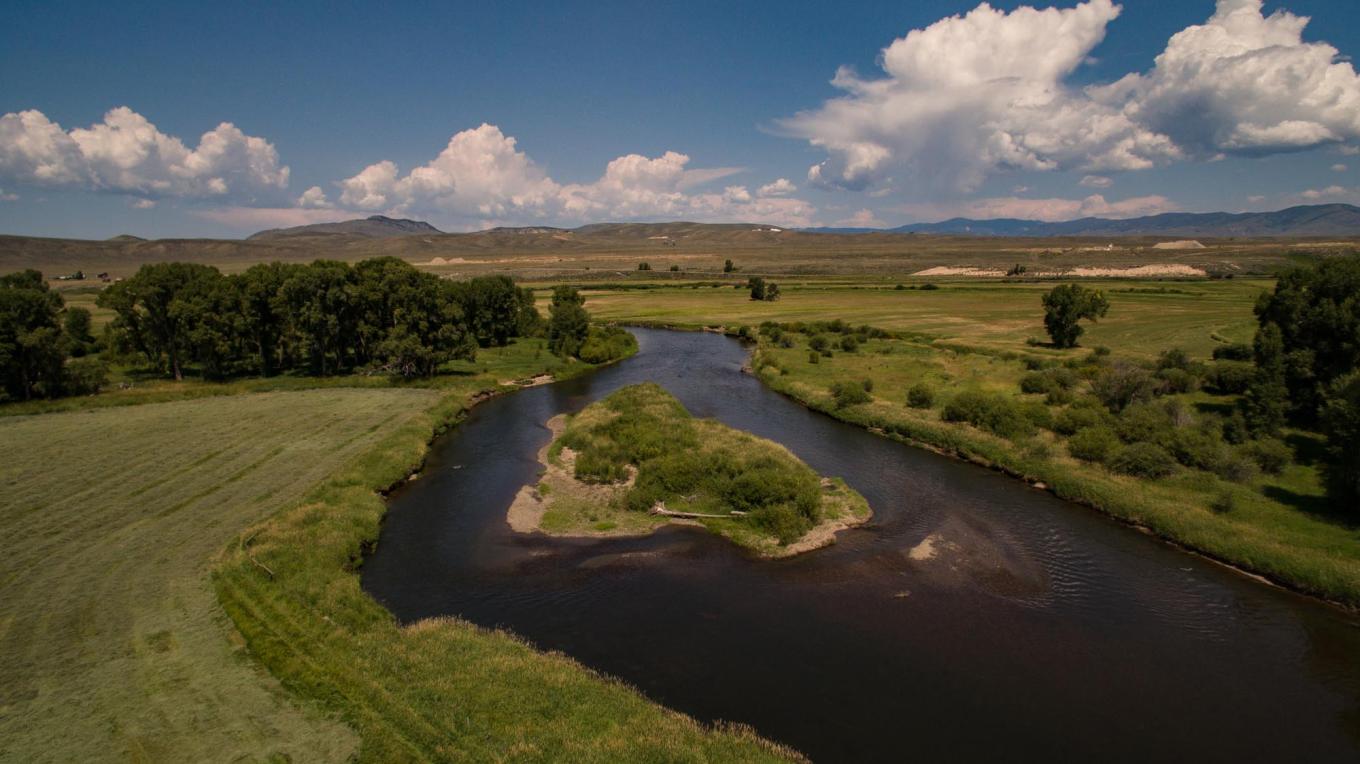
Joshua Duplechian
But no matter how you slice it, farmers and ranchers in the Colorado Basin face an ever-widening supply-demand gap. I was at Paul’s ranch because he was spearheading a group of nine flood irrigators in the Kremmling area, as well as scientists and conservation groups and the Connectivity Channel Project partners were in a multiyear research project to determine the short and longer-term impacts of withholding irrigation water from high-elevation perennial fields. In 2020, control fields were irrigated normally, while some test fields received no irrigation water, and others were irrigated for half a season. Standard irrigation patterns were restored for the three following years. The idea was to measure the amount of water used by plants, known as consumptive use, and the amount of crop production in the subsequent years after fallowing. At the time, the data available to understand the impacts of fallowing on individual operations and the local economy was almost nonexistent. These ranchers wanted to know what they were up against.
This is not the first time Paul has helped to corral his neighbors around river restoration efforts. In 2017, Paul and a group of 11 other ranchers, as well as a number of partners, including Trout Unlimited, American Rivers, the Colorado Basin Roundtable, and other river stakeholders, put together a proposal to restore a 12-mile stretch of the Upper Colorado River. The group was awarded $7.75 million to install instream structures that improved water levels for irrigation while enhancing critical river habitat with riffles and pools. At completion, this project benefited more than 30 miles (4) of the Colorado and 4,500 acres of irrigated lands while making available 11,000 acre-feet of water to improve the river during low-flow periods. It was just another proof point for Paul that if approached the right way, the interests of ranchers and farmers can align with those of conservation groups, state agencies, water providers, and other river users.
While the results of the irrigation study are not directly connected to demand management feasibility, they still could have important implications for any future program that attempts to pay irrigators to use less water. As we drove around the farm, Paul pointed out the cows milling in his brother’s front yard. They were running out of places to graze. He also mentioned that the ranch has one of the largest sage grouse populations and the largest blue heron rookery in the region as well as the longest-running dataset on deer in North America. “We have to make these things continue,” he says. Today, Paul is advocating for the utilization of data collected from key water conservation programs and the general understanding of how to integrate this data to make decisions to move forward with ongoing water conservation efforts, where and when necessary. He is frustrated by the lack of urgency in some of the conversations about the future of the Colorado. A life spent on this river has made him a weathered realist. He knows what’s coming, and he would rather be prepared than have his hands tied. “There’s no way you’re going to put a program into place that has every detail ironed out, and that makes every stakeholder happy,” he insists. “It’s going to be learn as we go, make mistakes, and then rectify those mistakes.”
Bryan Jones - Washington
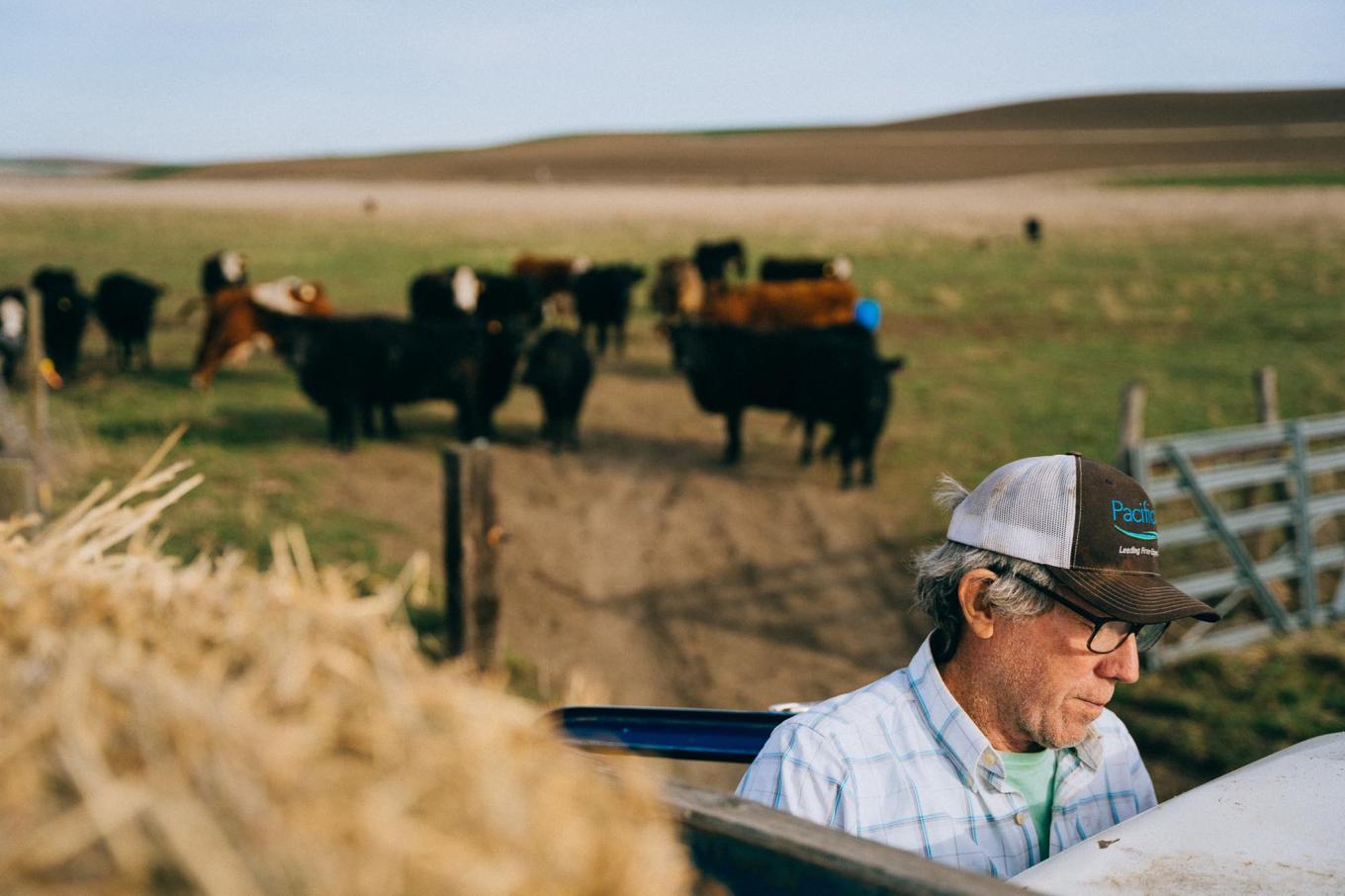
Jane Cavagnero
Bryan Jones remembers a time when he could shoot ground squirrels all day. He also remembers standing in his father’s fields in dust up to his ankles. This drove his father crazy, but the accepted practice at the time in the Palouse region (a large swath of farmland that includes Southeastern Washington and Idaho) was to raise wheat, harvest it, burn the remains, plow the land, and plant again. The Palouse contains some of the most productive wheat-growing land in the US due to its deep, fertile loess soil, essentially superfine, silty, windblown sediment. One hundred thousand years ago, Glacial Lake Missoula broke through an ice dam, sending thousands of tons of water, trees, rock, and debris careening across the landscape. The floods swept away the glacial topsoil, leaving behind the scoured Channeled Scablands in Southeastern Washington. One region’s loss was another’s gain, and the Palouse received much of these loess deposits, which created its signature rolling hills. On the southern border of the Palouse lies the Snake River.
Bryan farms on land that was initially acquired by his great-grandfather, who ran 20,000 head of sheep in 1868. By the time Bryan was growing up, his family had 500 head of sheep, and he remembers spending long nights helping sheep give birth and trying not to get the lambs mixed up. He left for the Navy, followed by university and then a stint in LA, but when his father had a five-way bypass, he took over the operation full-time. That was 1996. His farm originally consisted of 640 acres, but he rents most of it today and manages about 20 cows and a few acres of alfalfa. Few small farms remain in the region.
Bryan and his neighbors are dryland farmers, which means they don’t irrigate. Dry, silty soils combined with heavy tillage are a perfect recipe for dust storms. It is certainly no coincidence that Bryan’s farm is right outside of Dusty, Washington. Roughly half (5) of the topsoil in the Palouse has disappeared since the advent of the plow. So when Bryan learned about no-till, he became curious. He says that within a few years of cutting out tillage, his neighbors would stop by and remark, “Bryan, there are worms in your dirt.” He now serves on the Whitman Conservation Board, advocating for conservation practices and helping other farmers access funding and support for conservation projects.
Something else Bryan has become known for is his advocacy work to remove the four lower Snake River dams. The Columbia-Snake River system used to see 10-16 million (6) wild salmon and steelhead return to spawn annually. Since the dams were completed, return rates for salmon have rarely exceeded the two percent survival minimum. In 2022, NOAA Fisheries released a report (7) that concluded that removing the four dams on the lower Snake River as soon as possible is “essential” to avoiding salmon extinction and allowing populations to rebuild.

Jane Cavagnero
In 2006, Bryan had a fateful meeting with a Save Our Wild Salmon Coalition representative. Since then, he has been immersed in conversations around the decline of salmon and steelhead fisheries and the removal of the dams. He is on the Snake River Salmon Recovery Board and has become a somewhat lone farmer voice advocating for new opportunities for agriculture that support fish conservation while protecting the long-term viability of farming in the region.
When I asked Bryan how he came to care about salmon, he said it stems from watching the wildlife on his farm disappear. Bryan has kept a careful account of the animals that were once here. In addition to the ground squirrels, he watched the disappearance of the badger, the cottontail, the burrowing owl, the long-eared owl, and the short-eared owl. He says even the red ant, which used to build mounds all over his fields, is nowhere to be found.
Bryan is now working to restore his piece of riparian habitat on Alkali Flat Creek, which runs through his property and has been named a stream of priority by the Salmon Recovery Board. With the help of several conservation organizations, he has planted thousands of trees, from willows to junipers, pine trees, wild roses, elderberries, and hawthorns, up and down the creek. These riparian buffers can filter nutrients, pesticides, sediment, and animal waste from agricultural runoff. They stabilize eroding banks and provide shade, shelter, and food for numerous types of wildlife. He has already seen flocks of ducks and pheasants take refuge along the banks.
For farmers, the dams’ primary purpose is the transportation of grains. According to American Rivers, about 13-16 percent of all wheat exported through the PNW travels through the Snake River. Bryan is certain the Snake River Dams can be removed without harming farmers. “We can build a new toy set,” he says. His voice catches when he emphasizes that he is doing this for the agricultural community. “I want to keep farmers in the system,” he declares. “A lot of people don’t believe that. But I have always believed we must have a place for agriculture.” He is insistent that more farmers be brought to the table. And he’s hopeful that as more funding is made available farmers will shift their thinking around conservation and dam removal. Some of his neighbors are starting to follow his lead and restore the riparian areas around their creeks. It’s a slow drip, but it’s progress.
Although he has never seen one, Bryan says Alkali Flat Creek has a fish-bearing history. He recalls that as a kid, another child from up the road found a fish in the creek. “And it certainly wasn’t a trout,” he notes. As Bryan and I stand peering over at the thicketed creek, now starkly contrasted with the smooth undulating landscape, I ask him what he thinks about seeing a salmon here one day. “Wouldn’t that be wild?” he lets out a chuckle that catches him by surprise and then takes a sharp breath. “I’d be thrilled to death.”
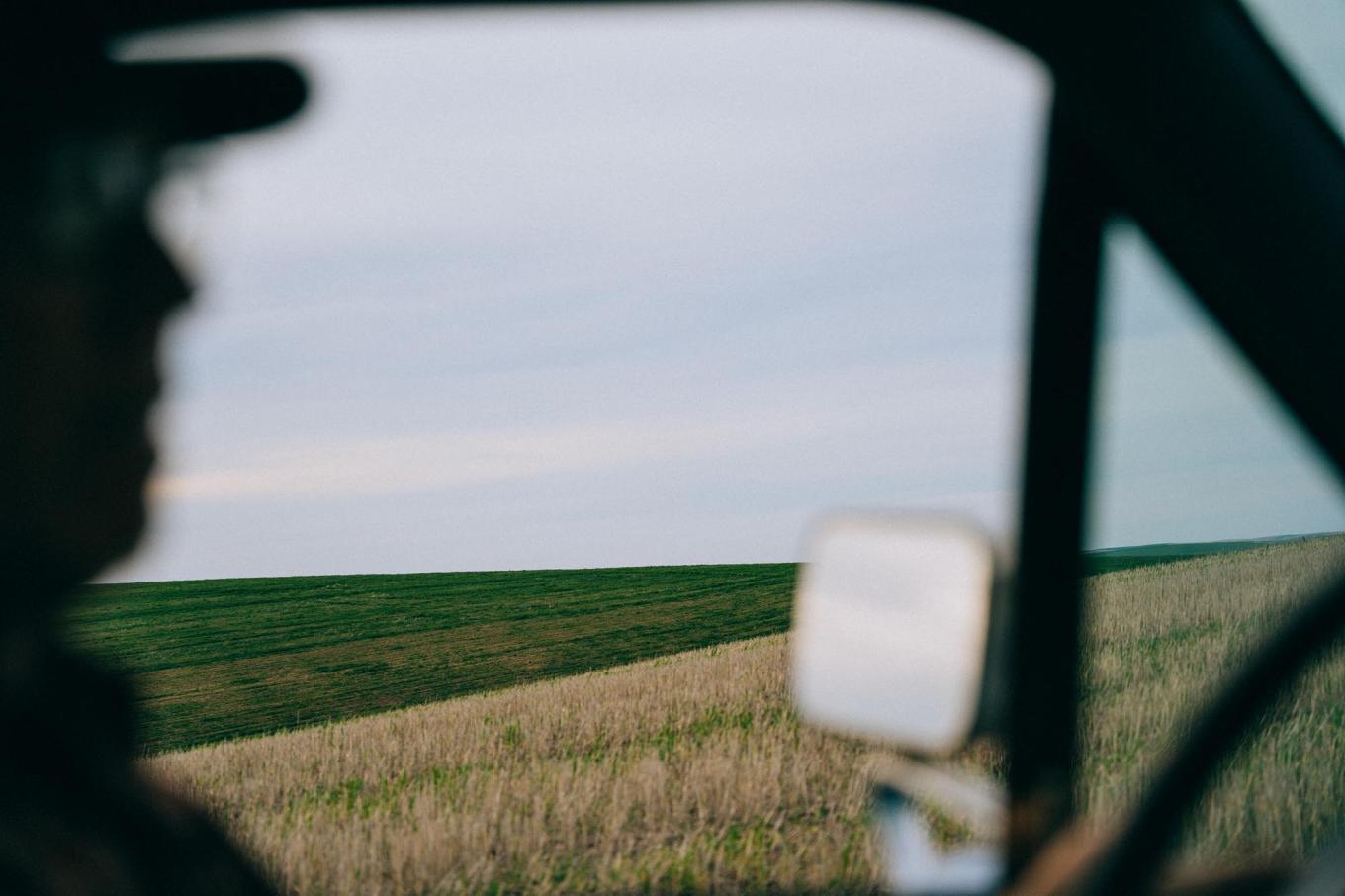
Jane Cavagnero
REFERENCES
